 On this page : Fogo (Cabo Verde), Long Valley (California), Shishaldin (Russia), Bardarbunga (Iceland), Kamchatka volcanoes (Russia), Colima (Mexico), Aso (Japan), Sinabung (Indonesia), Cerro Negro (Colombia), Indonesian volcanoes
On this page : Fogo (Cabo Verde), Long Valley (California), Shishaldin (Russia), Bardarbunga (Iceland), Kamchatka volcanoes (Russia), Colima (Mexico), Aso (Japan), Sinabung (Indonesia), Cerro Negro (Colombia), Indonesian volcanoes
This is an archived part of our Daily Volcano Activity report.
Click here to read the latest part of our report
This report is compiled out of many information sources.
For our El Hierro volcano report : Click here
Fogo, Cabo Verde Update November 28, 16:18 UTC
Again impressive eruptive explosions in the main vent. The eruption is intensifying at this moment, but the major part of Portula will probably escape devastation which is great news. The lava flow is now heading towards the hill above Portula. Unfortunately nobody will be able to predict at this time whether the flow will start again in the direction of the village or the other side. One thing is sure, you cannot do anything to deviate this thick layer of AA lava.
There are live images right now below this link
Indonesian volcanoes alert status
4 volcanoes are currently in SIAGA status (standby) or Alert level III on IV
Sinabung (Sumatra) since April 8, 2014
Karangetang (Siau) since September 3, 2013
Lokon (Sulawesi) since July 24, 2011
Slamet (Java) since August 12, 2014
Chiles and Cerro Negro volcano Update November 28, 09:59 UTC
Seismicity remains very high at this Colombia / Ecuador border volcano
Bárðarbunga update November 28, 01:18 UTC
The river of lava continues to expand the lava field. It's now almost 75 km2
ASO volcano, Kyushu, Japan Update
Japanese airlines were forced to cancel 49 flights as Mount Aso, which dominates the south-west Japanese island of Kyushu, spewed stones and ash.
The ash emissions have decreased a lot in the meantime.
Fogo, Cabo Verde Update November 27, 16:47 UTC
It is almost certain that a big part of the village of Portela will be destroyed by the advancing Lava. The flow advances slowly but as the feeder volcano is still erupting at full force high volumes of lava, it will be only a couple hours before the first houses of the village will vanish.
Follow the livestream here (we want to congratulate the video team at Fogo to regularly livestream images and to publish videos of this spectacular eruption).
Update 17:11 UTC : Unfortunately the LIVE event has just ended but save the link or let your browser tab active as LIVE footage will often restart. If your speakers are open, you will hear the sound of the commentator or other sound when it starts again.
Update 17:27 UTC : We are LIVE again
http://new.livestream.com/muzikatv/fogo
Fogo, Cabo Verde Update November 27, 16:24 UTC
SO2 from the eruption of #Fogo #volcano at the weekend, seen by Meteosat-10 http://t.co/8Pd4xVF1gn #Capeverde pic.twitter.com/U61Zzz5vZo
— EUMETSAT Users (@eumetsat_users) November 27, 2014
Fogo, Cabo Verde Update November 27, 15:46 UTC
Brand new video of some eruptive activity this morning. The video last 20 minutes has been shot a a distance but shows spectacular lava explosions with huge lava bombs.
#volcan #volcano #Fogo la carte des coulées/#lava flow mapped, via @fogonewscom pic.twitter.com/aBhmxl8AEZ
— CultureVolcan (@CultureVolcan) November 26, 2014
Fogo, Cabo Verde Update
Volcano eruptions are great nature events for us followers but have a cruel side-effect for those living alongside them. This happened today in Fogo (the people did evacuate most of their belongings luckily) - Picture initially published @ Culture Volcan
Fogo, Cabo Verde update November 27, 11:49 UTC
Volcano Activity for the week November 19 – November 25
Fogo | Cape Verde
According to news articles an eruption from Fogo's Pico cone inside the Cha Caldera began in the morning on 23 November after increased activity detected in the previous weeks and felt earthquakes by residents the night before. The eruption started at a vent on the WSW base of Pico cone, near or at where explosions originated in 1995, and then rose from multiple vents. The activity was characterized by explosions, lava fountains, and ash emissions. About 700 people evacuated from Chã das Caldeiras and the local airport closed. During the afternoon on 24 November workers removed items from the national park headquarters and by the evening lava had overtaken the building. Lava flows had crossed a main road and taken down communication poles. The Toulouse VAAC noted that a cloud observed in satellite images composed mainly of sulfur dioxide drifted over 220 km NW at an altitude of 9.1 km (30,000 ft) a.s.l. Ash in the cloud was detected at lower altitudes. By 25 November the lava flow was 4 km long.
Pavlof | United States
AVO reported that seismic activity at Pavlof decreased during 21-22 November but continued to remain above background levels. Weakly elevated surface temperatures during 22 and 24-25 November, consistent with the cooling lava flow on the NW flank, were observed in satellite images. The Aviation Color Code was lowered to Yellow and the Volcano Alert Level was lowered to Advisory on 25 November; AVO noted that seismicity was at low levels during the previous week, and satellite observations show no evidence for continuing eruptive activity.
Popocatepetl | Mexico
CENAPRED reported that during 19-25 November seismicity at Popocatépetl indicated continuing emissions of water vapor and gas. Incandescence from the crater was visible each night. On 21 November a plume with low ash content rose 700 m above the crater and drifted NE. The Alert Level remained at Yellow, Phase Two.
Sinarka | Shiashkotan Island (Russia)
SVERT reported that satellite images of Sinarka showed steam-and-gas emissions on 19 November. Cloud cover obscured views on the other days during 17-24 November. The Aviation Color Code was raised to Yellow.
Page cutoff
I guess a lot of people will be happy that we just have decreased the length of this page. The archives part can be found here
Sinabung volcano, Sumatra, Indonesia yesterday
Flujos piroclásticos en la erupción del #Sinabung (Indonesia) 25/11 - 13.00 pm - via @SinabungVolcan pic.twitter.com/BYq0YsRSe7
— IGEO (CSIC-UCM) (@IGeociencias) November 26, 2014
Aso volcano, Japan and tourism
#volcan #volcano #Aso y a-t-il un lien entre tourisme et volcanisme actif/is there a link Btween tourism & volcanism? pic.twitter.com/ZTgHbNCLQj
— CultureVolcan (@CultureVolcan) November 26, 2014
Awesome videos of the Aso volcanic eruption! http://t.co/Zv5h5KuDkI pic.twitter.com/wVBkdxPfTn
— Janine Krippner (@janinekrippner) November 26, 2014
Colima, Mexico
Some great before and after shots of the recent explosion at @Volcan_Colima via @tapirofoto: https://t.co/3bs8arBfky pic.twitter.com/jjCVE4FsMk
— Mike Cassidy (@MikeVolc) November 25, 2014
Fogo, Cabo Verde update November 26, 00:37 UTC
Another great video from the action on the third day. The AA lava flow is thickening further. An unusual view in Fogo is that the people who had to evacuate their houses are now sitting in the open air on a slope next to the new lava field.
Fogo, Cabo Verde update November 25, 09:49 UTC
New Video shows that 3 vents are active and are emitting lava and ash at full strength. Some lava bombs are really huge. Especially the sound of the emitted ash is impressive.
#volcan #volcano #Fogo: le départ de l'éruption vu par /start of the eruption seen by @eumetsat http://t.co/Yorf92V4WM
— CultureVolcan (@CultureVolcan) November 24, 2014
Zhupanovski volcano, Russia satellite images are showing an ash explosion
#volcan #volcano #Zhupanovsky nouvelle explosion ce matin/news ash plume today http://t.co/d4iwDICKsp pic.twitter.com/4OxUhOrYdt
— CultureVolcan (@CultureVolcan) November 25, 2014
Ash plume from Zhupanovsky volcano over Avachinsky & Kozelsky volcanoes, Kamchatka http://t.co/iRLkXQCr5J pic.twitter.com/sv2s4898kl
— Janine Krippner (@janinekrippner) November 25, 2014
Bárðarbunga scientific advisory board update November 25, 09:54 UTC
The volcanic eruption in Holuhraun continues to be strong. The lava flow and the gas emission in the volcanic plume is more fluctuating than it has been. There is a double pulse cycle, or fluctuation, one takes hours and the other takes between 10 and 20 seconds.
* Seismic activity in Bardarbunga continues to be strong. The biggest earthquakes that was detected since noon on Friday, were of magnitude M5,1 on Sunday, 23. November at 09:22 and this morning, 24. November, at 09:03 of magnitude M5,4. In total 36 earthquakes bigger then M4,0 were detected over the period and 56 earthquakes between M3,0-3,9. In total about 250 earthquakes were detected in Bardarbunga since noon on Friday.
* First analysis from a new seismograph, which was installed on Bardarbunga on 11. November, shows that the earthquakes in the Bardarbunga caldera originate in the uppermost three kilometres of the earth’s crust. This indicates that the magma is closer to the earth’s surface than was estimated before.
* On Saturday, 22 November, at 00:51 an earthquake of magnitude M1,7 was detected in the dyke. In total about 80 earthquakes were detected in the dyke and around the eruption site in Holuhraun since Friday.
* The subsidence of the Bardarbunga caldera and tectonics continues with similar rate as last few weeks. Tectonics movements show depression towards Bardarbunga.
Fogo, Cabo Verde update November 24, 16:43 UTC
And another great video of this powerful Strombolian eruption. The lava type is AA lava
Fogo, Cabo Verde update November 24; 14:31 UTC
The best eruption video so far
Shishaldin volcano, Alaska
Seismic activity has increased over the past two hours and more sharply over the past 30 minutes, suggesting that the eruption at Shishaldin has intensified. Ash emissions beyond the immediate summit crater are more likely while seismic activity is increased. Satellite images from earlier tonight show elevated surface temperatures near the volcano's summit.
Mammoth lakes Long valley caldera, California update November 24, 13:15 UTC
There we go again, a new swarm seems to have started, mostly micro quakes. No danger at the current hypocenter depths. The micro quakes indicate however lava on the move
Fogo, Cabo Verde update November 24; 10:25 UTC
The Fogo eruption on Cabo Verde islands resulted in the evacuation of hundreds of residents and the closure of a local airport.
Video of the eruption captured by a local islander
#Vulcano #Fogo #Eruption #CaboVerde @AniceBarbosa: Photos from Fogo today pic.twitter.com/VpEp0WS4KH
— NaR R. Berlanga (@nrosabe) November 23, 2014
Fogo volcano, Cabo Verde enters in eruption Update November 23, 15:10 UTC
The volcano's last eruption was in 1995. The eruption started this morning at 10:00 local time (11:00 UTC).
The volcanologists had enough precursors to send an evacuation call to the people living near the volcano. Signs of increased activity were recorded since many weeks and even months.
The eruptive cloud was detected by the VAAC from Toulouse. A red aviation alert has been issued for the region around the volcano. There is almost NO ash in the air at this moment (see VAAC image below)
As there are NO live links with the instruments on Fogo, we can only guess on what is happening. Fogo has normally Strombolian eruptions. Strombolian eruptions are powerful lava fountains when the eruption starts but are mostly limited in time, lava flows are a normal part of it.
The best website to follow this eruption is the one from Observatório Vulcanológico de Cabo Verde (OVCV)


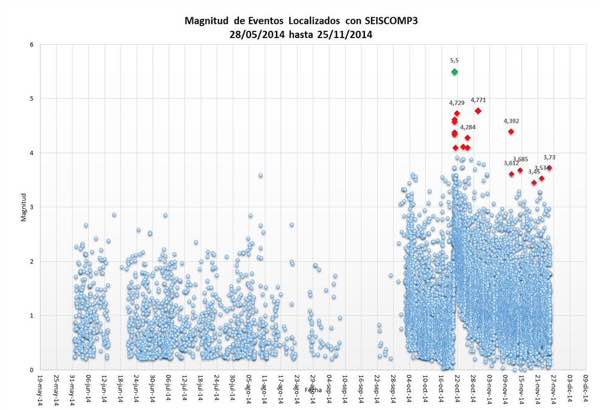






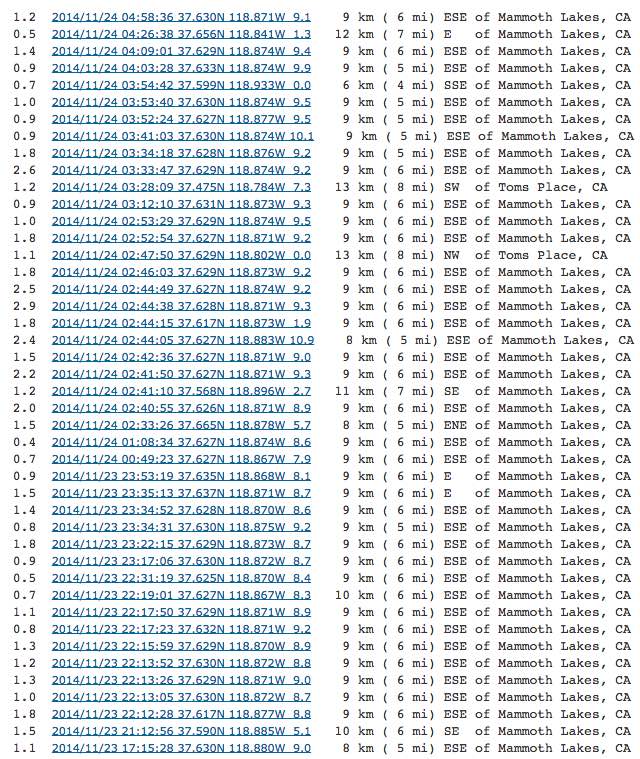





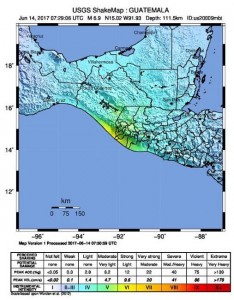
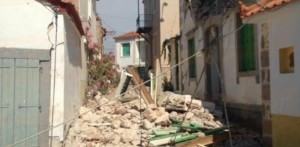
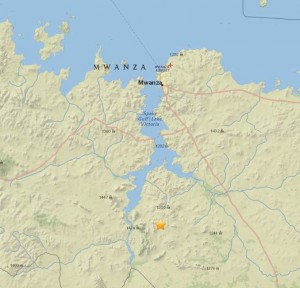
A huge landslide generated tsunami waves damaging some villages in Greenland - 4 people (remain) missing